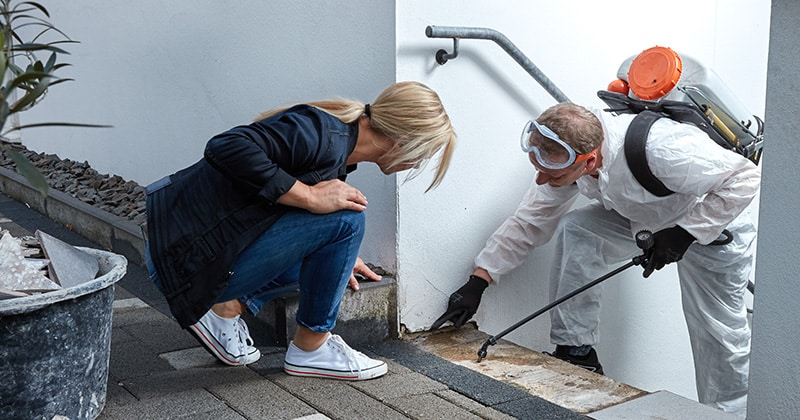5 Strategic Insights for Pest Control Companies
The extermination business is competitive. The right strategic insights for pest control companies can help pros meet clients’ needs, deploy the latest techniques, and stand out from competitors.

Staff Contributor
In 2023, 31,567 businesses were active in the US. Competition varies by location and specialty. But professionals can develop a solid strategy to stand out from other companies.
The pest control industry is competitive. But today, pest control pros use emerging technology and tech-assisted methods. These ensure a better chance of successful insect or rodent removal. But a reputation for successful removal is only part of the picture.
Strategic insights include methods for handling the basics. For example, pest experts need software for effective scheduling and customer communication. Also, billing and booking tools for streamlined accounting are important.
Lastly, your company’s strategy should include marketing and customer relationship management. This article will take a closer look at each of these areas. Then, we will provide advice for using each in your company.
5 Emerging Technologies and Innovations Shaping the Landscape of the Pest Control Market

Some tech-enabled products improve pest control. But many innovations add something new to existing techniques. The goal is to make products or practices safer and improve effectiveness.
Here are examples of these improvements:
Biopesticides
Biopesticides use natural ingredients instead of chemicals. These can include bacteria, viruses, or fungi. These things occur naturally in the wild and aren’t harmful to people or plants. Yet they kill or repel some pests.
Some plant extracts or oils can harm insects without killing them. For example, a natural compound can stop reproduction for some bugs.
Pheromones are new to pest control. These natural chemicals attract or repel pests. A pheromone added to a pesticide could draw bugs into a trap. They might rub against pesticides in the trap area.
With this strategy, pest control pros can treat an area safely. They won’t be spreading chemicals everywhere during treatment.
Smart Traps
The Internet of Things (IoT) brings new techniques to pest control. IoT sensors and cameras can find and ID insects or other pests. These tools help in several ways.
First, traps can use cameras or GPS to find and ID pests. Then, pros know which areas to treat. They can also see what bugs or rodents are there. With this information, they can choose the best treatment methods.
Second, pest control companies can work remotely. Cameras can ID pests in the trap and count them. Then, you can see if the methods are effective and make adjustments.
With the right equipment, you can handle everything remotely. You have to place and set the traps. Then you can manage the rest of the process via computer. In other words, you can provide attentive service to clients without being on-site.
Artificial Intelligence (AI) Analytics
Pest info can provide insights into infestations. It can also give early warning of pests moving to a new area.
AI uses algorithms to analyze this info constantly. It can spot trends even earlier. And it can predict problems or population growth. These forecasts are from temperature or habitat changes.
These insights can help pest control companies ID insects or rodents in an area. They can also help you plan. With early predictions, you know which equipment and chemicals to stock.
These predictions can also help you prepare marketing materials. You will be ahead of other companies with advertising when infestations start.
Genetic Pest Control
Genetic pest control is a new strategy. It involves releasing new pests into an area. The new introductions mate or live with the infesting pests.
This treatment could have different goals. The new insects or rodents could:
- Carry a disease that harms the other pests
- Pass on new genes that would make it harder for future pests to survive
For instance, a released mosquito could mate with other insects in the area. When they do, they pass genes that make future egg-laying impossible.
A similar idea is to release sterile mosquitos. They produce no offspring after mating, lowering the population.
The technique can limit pest populations in the long term. Also, it doesn’t need chemicals. Companies can provide large-scale treatment without harming people or nature. This technique is popular as an eco-friendly option for insects.
Integrated Pest Management (IPM)
IPM is a holistic strategy. It includes inspection and prevention. It can also include landscaping for pest control.
For example, you can plant trees or flowers that pests don’t like. Or look for plants that attract a pest’s natural predators.
Traps, pesticides, and fences can also be part of IPM. You can speed up these methods if the first ones don’t work.
Pest control companies can provide IPM expertise and do maintenance treatments. Also, companies inspect the area to check for infestations or new pests.
IPM can also include IoT sensor analytics and data platforms. These tools measure pest levels. They then alert you to increases. You can then change strategies as needed.
5 Insights and Strategies for Managing Your Pest Control Businesses

Advanced strategic insights for pest control companies are valuable. But business owners and managers also need the basics. Bookkeeping, marketing, and customer relationship management (CRM) are essential in this competitive industry.
Here are five of the most important strategic insights for pest control leaders:
1. Create a Customer Relationship Strategy
Existing customers are important for business. More revenue comes from repeat clients than from new ones.
Pest control companies can offer seasonal or annual services. With IPM, repeat visits and inspections are common. And companies need to keep communications going to remind customers of their services.
Manual communications, like emails, are time-consuming. Instead, you can automate the process.
A customer relationship management (CRM) platform can automate emails or texts. It can send marketing emails or reminders about appointments. You can also automate follow-up and thank-you emails after an appointment.
Different strategies may work for your company. But, you should always define your approach. Then, use the same methods for each customer. You can see what works. You also see what fails. Use that data to make changes and improvements as you go.
2. Focus on Pest Management
Many customers will only consider pest control services when they have an infestation. Pest management and prevention are much easier. They help customers avoid infestations in the first place. Also, prevention is easier than full extermination projects.
Pest management strategies can include smart traps, monitoring, and IPM strategies. These do not involve chemical pesticides. So, pest management is more eco-friendly. Also, it is safer for spaces where kids and pets play.
Pest management has two important parts. First, your company needs to find methods that produce real results. You need to build a good reputation. The best way to do this is to show measurable results using proven methods. Keep up with new techniques that could produce better results.
The second step is to market the idea to customers. They may not think it’s important to prevent pests. You want to show verifiable results. Convince them that prevention works. Then, they will be more likely to use the services.
3. Set the Stage for Continuous Improvement
Education is key in every industry. Both you and your employees can keep learning new things to improve performance.
Remember, pest control is a results-driven industry. You need to perfect proven methods. You also need to learn new techniques that may work better.
Ten years ago, analytics and AI were not a part of pest control. Now, they drive results and help companies stay ahead of trends. You may fall behind if you don’t learn to use these tools.
Encourage workers to learn new skills as well. Lead by example. Train yourself to use them first.
Customers often hear about new techniques. They want to know if they’re effective. If you have that information, use it to stand out.
For example, learn how to apply biocides. You can then market environmentally friendly pest control. The same could work for IoT-enhanced traps or other high-tech options.
4. Focus on Safety and Compliance
Federal laws govern the use of pesticides. Managers are responsible for compliance. You need to ensure proper use. If you do not, you could get fined.
Many states and cities have localized laws, too. You also need to understand and follow these.
Failure to follow rules can also lead to civil suits. You may be liable for illness or damage if you don’t apply chemicals properly. This issue could lead to increased insurance premiums for your business.
Finally, you need to ensure workers understand all laws. They should receive training on the safe use of products and tools. If new rules are in effect, you must update employees before sending them into the field.
5. Get Certifications
Experience matters in pest control. You can formalize your skills by getting certifications. Often, these accreditations can help you get more clients. You can use them in your marketing materials.
Each state has different names for official certifications. In some places, you need to be a Certified Pest Control Operator or Pest Control Technician. It’s required for all pest control techs.
Other places have licenses for pesticide application or pest inspection. Most of these mean the same thing.
The certificate process usually involves:
- Paying a fee
- Taking a class
- Passing an exam
Sometimes, you can skip the class. But you’ll have to study for the exam on your own.
National certificates can also help. The National Pest Management Association (NPMA) has the QualityPro program. It offers certifications such as Schools Certified Pest Management.
You can be a GreenPro Certified Pest Management professional. You’ll then be certified for eco-friendly treatments.
You may see more opportunities in the food service industry. Specialties like Food Certified Pest Management are also available.
Other certificates are available statewide or regionally for specific pests. These include mosquito control, termite inspection, and bed bug specialist.
Finally, workers dealing with nuisance wildlife can become Certified Wildlife Control Professionals (CWCP). This certificate comes from the National Wildlife Control Operators Association (NWCOA). Some states may ask for this license if you trap animals larger than mice or squirrels.
The Role of Artificial Intelligence in Pest Control Marketing

AI plays an important role in pest control marketing. Yes, analytics of insect populations can help you market specific pest services. But the help goes beyond local insects and mice.
Algorithms can define customer categories, personalize advertising, and automate communications. With AI, you can spend less time on marketing and get better results.
AI software can use data to create actionable insights. Collect information about each customer’s service requests. Learn their preferences and concerns.
AI can use this data to create a profile. It can analyze the data. Then, it may offer suggestions for promos, marketing emails, and discounts.
AI automates almost everything. An AI program can look for data on pest problems in a local area and combine it with customers’ service history. The AI can tell you which pest services to include in marketing emails.
These insights can help increase sales. For example, 76% of consumers say they’re more likely to buy from companies with personalized marketing.
Chatbots and automated emails and texts are common in every industry. AI can collect information from initial questions.
Some programs even handle interactions like scheduling appointments. Then, they deliver customer profiles so that you can plan each service visit.
AI software can use customer data to write personal follow-up emails or texts. This means you are free for service and management tasks.
Only the Best Marketing for Pest Control Companies

Basic marketing techniques work for every industry. But some tactics work especially well for pest control companies.
Consider Seasonal Marketing
Seasonal marketing is important in pest control. Clearly, you don’t want to advertise mosquito control in the winter. Many pest problems are seasonal. They are based on nesting, reproduction patterns, and life cycles.
You need to prepare marketing materials before each season begins. Then, customers will see the materials when the pests first appear.
This tactic requires knowing the pest patterns. You must also understand how they vary for each location in your service area.
Highlight Safety
People will be aware of new developments in pest control. Many will be aware of nonchemical treatment options.
Others may worry about the safety effects of certain pesticides. Humane removal and no-kill traps might also be important.
A related tactic is to highlight safety. Customers have access to resources like the National Pesticide Information Center.
Those with families and pets may have concerns that you can address upfront. Even those not worried about chemicals will appreciate data on effectiveness.
Embrace New Products with Partnerships
Partnerships can provide additional marketing clout and materials. Pest control product producers often seek partnerships with service providers.
Some offer certification. This may involve simply using the product. It might also mean training in the proper application.
These relationships can include wholesale pricing. Also, they often come with marketing material. The brand may even have a search feature on its website. The list allows customers to find local partners in their area.
Use Case Studies and Testimonials
Some customers may respond to online ads or social media posts. Others want more information. You can reach these people with case studies detailing results. Cover different pests or treatments.
Combine studies with testimonials. Gather them from people who were happy with your service. Display the quotes on your website. They may also reach an audience on social media.
Both types of marketing allow you to highlight new methods. You can use them to prove your traps, treatments, and prevention services work.
Focus on Local Advertising
Local SEO is important for service businesses. Google claims one-third of all searches are location-based.
Web traffic from pest control searches is not helpful if it is not local. Someone from another state is not going to use your service.
You want people to find you when searching in their area. Your SEO can include major streets, cities, suburbs, neighborhoods, and place nicknames. Look for opportunities to use “pest control near me” or similar phrases.
Take this a step further. Combine place keywords with some about local pest problems. This allows for more focused targeting.
Produce Content Marketing
Content marketing builds your image as an expert. Blog posts, long articles, and social media posts about services work. Videos, podcasts, and pictures can provide valuable content, too.
Aside from your services, provide DIY prevention tips. At the end of the video or article, you can offer services for more difficult problems.
Kevin is an experienced content expert with experience in marketing strategy, creative writing, video production, social media, and team training. Additionally, he also has a master's degree focused in Playwriting from Texas State University.

Business Solutions For Field Service Pros
EverPro offers specialized solutions designed for home and field service professionals. We’ve got the business tools to help you get the job done.



